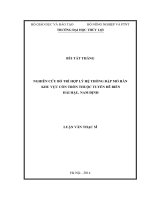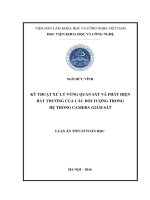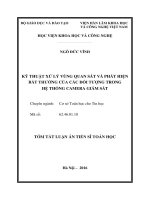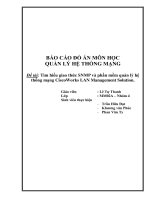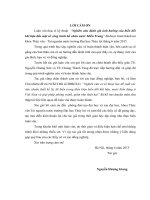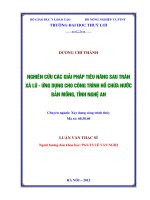Nghiên cứu phân bổ nguồn nước và vận hành hợp lý hệ thống hồ chứa lưu vực sông vu gia – thu bồn trong mùa cạn tt tiếng anh
Bạn đang xem bản rút gọn của tài liệu. Xem và tải ngay bản đầy đủ của tài liệu tại đây (1.57 MB, 32 trang )
MINISTRY OF EDUCATION
AND TRAINING
MINISTRY OF
AGRICULTURE AND RURAL
DEVELOPMENT
VIETNAM ACADEMY FOR WATER RESOURCES
Ph.D Candidate TO VIET THANG
STUDY ON ALLOCATION OF WATER RESOURCES AND
RATIONAL OPERATION OF RESERVOIRS SYSTEM IN
VU GIA – THU BON RIVER BASIN IN DRY SEASON
Specialization: Water resoures engineering
Code: 9 58 02 12
Executive summary of Ph.D Thesis
Hanoi 2019
This Thesis was completed at: Vietnam Academy for Water
Resources
Supervisor 1: Assoc. Prof, Dr. Ngo Le Long
Supervisor 2: Assoc. Prof, Dr. Nguyen Tung Phong
Reviewer 01:
Reviewer 02:
Reviewer 03:
The thesis will be defended at the Academic Council of Vietnam
Academy for Water Ressources
At…….. 2019
The thesis can be reached at:
-
National Library
-
Vietnam Academy for Water Resources Library
MỤC LỤC
LIST OF PUBLICATIONS ............................................................. 5
INTRODUCTION ............................................................................ 6
1. Rationale of the thesis ................................................................ 6
2. Objective the thesis..................................................................... 7
3. Subject and scope of the research ............................................... 7
4. Methodology............................................................................... 7
5. New contribution of the thesis .................................................... 7
6. Structure of the thesis ................................................................. 8
CHAPTER 1: OVERVIEW OF RESEARCH SITUATION AND
CALCULATION METHODS OF RESERVOIR OPERATION
FOR WATER RESOURCES IN RIVER BASIN .......................... 8
1.1. Overview of research on distribution of river basin water
resources in the world and in Vietnam ..................................... 8
1.1.1.
Literature review of reservoir water allocation using
simulation method ...................................................................... 8
1.1.2.
Literature review of reservoir water allocation using
optimization methods .................................................................. 9
1.1.3.
Literarute review of reservoir water allocation using
simulation-optimization method ............................................... 10
1.2. Literature review of reservoirs in Vu Gia - Thu Bon river basin
11
1.3. Summary of the Rule of inter-reservoir operation (Rule 1537)
on the VGTB river basin ........................................................ 12
1.4. Limitations and gaps in the study of inter-reservoir operation
and allocation of water resources reasonably at Vu Gia LVS Thu Bon .................................................................................. 12
1.5. Conclusion Chapter 1: Approach and orientation of the
research steps of the thesis ..................................................... 13
CHAPTER 2: RESEARCH ON SCIENTIFIC BASIS for
MODELS OF SUPPLYING WATER RESOURCES AND
OPERATING THE SYSTEM OF RESERVOIRING FOR VU
GIA THU BON RIVER BASIN - IN THE DRY SEASON ........ 15
2.1. Introduction of reservoir system in Vu Gia - Thu Bon river
basin and select reservoirs for research .................................. 15
2.2. Building a random simulation model of the flow to the
reservoir taken into account the hydrological correlation in the
system..................................................................................... 16
2.2.1. Determine the type of probability distribution for the
flow chain to 04 reservoirs ....................................................... 16
2.2.2. Set up hydrological correlation amongst river branches
16
2.2.3. Tạo chuỗi số ngẫu nhiên thời đoạn 10 ngày tới 04 hồ . 17
2.3. Develop a model of operating multi-purpose reservoir system
18
2.3.1. Problem establishment ................................................. 18
2.3.2. Develop optimal search model and connect to reservoir
operation simulation model ...................................................... 20
2.4. Develop a simulation operation model for linkage-reservoir
HEC-RESSIM ........................................................................ 21
2.5. Conclusion of chapter 2.......................................................... 22
CHAPter 3: CALCULATION RESULTS OF SYSTEM
OPERATION IN VU GIA THU BON RIVER BASIN – to
IMPROVE EFFICIENCY OF WATER allocation ..................... 23
3.1. Identify scenarios to operate 04 reservoirs ............................. 23
3.2. Summary of calculation results of all scenarios ..................... 25
3.3. Using HEC-RESSIM model to details calculate selected
scenarioes ............................................................................... 27
3.3.1.
Simulation of operation in 2015 and 2016 ............... 27
3.3.2.
Simulated operation in 1981-2008 ........................... 29
CONCLUSIONS AND RECOMMENDATIONS ....................... 30
1
LIST OF PUBLICATIONS
1. Tô Việt Thắng, Ngô Lê Long, Nguyễn Tùng Phong (2018),
Research on contribution ratio of large upstream reservoirs for
minimum flow in Vu Gia – Thu Bon river system, Hội thảo quốc tế:
Water Security and Climate Change (Nairobi, Kenya 12/2018);
2. Tô Việt Thắng (2018), Nghiên cứu tính toán vận hành hệ thống
liên hồ chứa lưu vực sông Vu Gia – Thu Bồn trong mùa cạn bằng mô
hình HEC-RESSIM, Tạp chí Khoa học kỹ thuật thủy lợi và Môi
trường 09/2018;
3. Tô Việt Thắng (2018), Method for optimal water allocation of
reservoirs system – a casestudy of Vu Gia – Thu Bon River basin,
Vietnam, Hội thảo quốc tế: IWA World Water Congress &
Exhibition, (Tokyo, Nhật Bản 9/2018);
4. Tô Việt Thắng, Ngô Lê Long, Nguyễn Tùng Phong, Lars Ribbe
(2017), Nghiên cứu tạo chuỗi số liệu dòng chảy với mô phỏng Monte
Carlo phục vụ bài toán phân bổ hợp lý nguồn nước lưu vực sông Vu
Gia – Thu Bồn, Tạp chí khoa học và công nghệ Thủy lợi 02/2017;
5. Tô Việt Thắng, Ngô Lê Long, Nguyễn Tùng Phong (2017),
Nghiên cứu xây dựng mô hình tối ưu phát điện, cấp nước các hồ
chứa trên lưu vực sông Vu Gia – Thu Bồn trong mùa cạn, Tuyển tập
hội nghị khoa học Thủy lợi toàn quốc 2017 (có trình bày trước hội
nghị);
6. Tô Việt Thắng, Ngô Lê Long, Nguyễn Tùng Phong (2017),
Nghiên cứu mô phỏng chuỗi dòng chảy ngẫu nhiên đến hồ chứa đảm
bảo tính đồng bộ thủy văn hệ thống sông Vu Gia – Thu Bồn, Tuyển
tập hội nghị khoa học thường niên 2017 – Đại học Thủy lợi (có trình
bày trước hội nghị);
7. Tô Việt Thắng, Ngô Lê Long Nguyễn Tùng Phong (2016), Nghiên
cứu thiết lập bài toán phân bổ nguồn nước hợp lý hệ thống hồ chứa
đáp ứng nhu cầu sử dụng nước lưu vực sông Vu Gia – Thu Bồn trong
mùa cạn, Tuyển tập hội nghị khoa học thường niên 11/2016 – Đại
học Thủy lợi (có trình bày trước hội nghị).
2INTRODUCTION
1. Rationale of the thesis
Nowaday, the allocation of water resources among households using
water is not a simple problem in many river basins (Harou, Paredes,
Solera, & Andreu, 2012). When water demand is low compared to
the supply capacity of the system, all water users can coexist without
conflict or dispute. However, as water demand increases among
water users such as households, agriculture, industry, hydropower,
etc., conflicts of interest will increase, especially in the dry season
(Liu, Chen, & Lou, 2009), leading to difficulties in managing water
resource allocation effectively.
The Vu Gia-Thu Bon river system (VGTB) is the largest interprovincial river system in the central coast of Vietnam. The
construction of a system of hydroelectric reservoirs on the river has
made the management and allocation of water resources to different
water users in the river basin become complicated and difficult.
Conflicts between water use goals become more profound, especially
in the dry season requiring a solution of "compromise" between
objectives to improve the efficiency of water resource allocation for
river basins.
Therefore, the PhD student has chosen the topic of "Research on
allocation of water resources and proper operation of reservoir
system in Vu Gia - Thu Bon river basin in dry season" as a doctoral
thesis research topic.
The research content of the thesis will focus on solving the problem
of combining simulation and optimization of reservoir system
operation, especially in the dry season as a basis to serve the
allocation of water from hydropower reservoirs. The thesis will focus
on researching the scientific basis, setting up the problem, the
approach from which to propose simulation-optimal model of inter-
reservoir regulation for multi-purpose uses. The study will be applied
to large reservoirs on the VGTB river system.
2. Objective the thesis
- Establishing a scientific basis for rational water allocation of
reservoir system to meet the needs of VGTB river basin in dry
season;
- Propose a plan to coordinate the operation of the reservoir system,
ensuring intergrated economic efficiency (highest).
3. Subject and scope of the research
- Subject of research: Reasonable allocation of water sources for
reservoirs A Vuong, Song Bung 4, Dak Mi 4 and Song Tranh 2 on
VGTB river basin.
- Scope of the research: VGTB river basin system in dry season.
4. Methodology
- The thesis uses the following methods: (i) Method of field
investigation; (ii) Methods of statistical analysis; (iii) System
analysis method using simulation model and optimization of use in
inter-reservoirs operation; (iv) Expert method and community
participation; (v) Method of hydrological and hydraulic modeling.
5. New contribution of the thesis
- Building a scientific basis for operating the reservoir system in
rational allocation of VGTB river basin water resources in the dry
season;
- Proposing the optimal operation rule of the four largest reservoirs
in the VGTB river basin, including (A Vuong, Song Bung 4, Dak Mi
4 and Song Tranh 2 reservoirs) to ensure maximum electricity
production volume from power generation and harmonization target
reservoirs to meet downstream water supply requirements;
6. Structure of the thesis
The thesis consists of 130 pages, 17 tables, 54 figures and 55
references. In addition to the introduction and conclusion,
the thesis consists of 3 chapters:
Chapter 1: Overview of related research and methods for reservoir
operation and allocation of river basin water sources
Chapter 2: Research on scientific basis to build a model of water
allocation and rational operation of VGTB river basin reservoir
system in dry season.
Chapter 3: Results of calculation and operation of reservoir system in
VGTB river basin to improve the efficiency of water resources
allocation.
3CHAPTER 1: OVERVIEW OF RELATED RESEARCH AND
METHODS OF RESERVOIR OPERATION FOR WATER
RESOURCES IN RIVER BASIN
1.1.
Overview of research on distribution of river basin water
resources in the world and in Vietnam
The methods of operation, management and allocation of reservoir in
the river basin according to the system operation model can be
mentioned as the method of using simulation models, optimization
methods and tissue combination methods simulation and
optimization (Louck and Eelco van Beek, 2005), (Liu et al., 2009),
(Husain, 2012), (Fayaed, El-Shafie, & Jaafar, 2013) and (Ahmad, ElShafie, Razali, & Mohamad, 2014)...
1.1.1.
Literature review of reservoir water allocation using
simulation method
In the field of integrated water resources management, the first
simulation method was used by the US Army Engineers Association
(USACE) to plan and manage Missouri River water resources in
1962 (Rani & Moreira, 2010).
Subsequently, the Harvard Water Program applies a technique to
simulate the economic designs that apply to water resources (Rani &
Moreira, 2010), (Mckinney, Cai, Rosegrant, Ringler, & Scott, 1999).
Gradually, complete simulation models were developed and
introduced as HEC family models (HEC3, HEC5, HEC RESIM) developed at the Hydrologic Engineering Center (HEC) of US
military, serving for reservoir simulation (Rani & Moreira, 2010),
(Fayaed et al., 2013).
Some other basin simulation models are MITSIM, WUS, MIKEBASIN WEAP. These are models that can be capable of simulating
complex river basin systems.
However, although widely used in field of integrated water resources
management in general and in simulation of water allocation from
reservoir systems in river basins in particular, the simulation method
still has a limited point when only provide the best operation plan in
simulation scenarios. Therefore, in parallel with the simulation
method, the optimisation method has been developed and applied in
many studies.
1.1.2. Literature review of reservoir water allocation using
optimization methods
Optimization is a method of finding the best option in possible
alternatives. The most important component in optimization is the
objective functions, through which to determine the optimal
solutions - the target solution satisfies all the assumptions and
constraints.
John W. Labadie (2004) summarized the optimal techniques used in
the problem of water allocation from reservoirs and multi-purpose
reservoir systems on the same river basin, including a group of
implicit stochatic optimization methods and explicit stochatic
methods.
In the past two decades, heuristic algorithms (self-experimental
algorithms) have been developed to solve the optimal problem of
water allocation, especially the optimal reservoir operation. The
important benefit of this approach compared to traditional methods
is: it can approach the global optimization for a practical problem
rather than global optimization for the simplified problem (Maier,
2014).
Some newly developed algorithms include genetic algorithms (GA),
fuzzy set theory algorithms (FUZZY SET THEORY), Neural
network algorithm (ANN).
Young (1967) proposed for the first time to use linear regression
method to outline general operating rules from defined optimization.
After that, many authors in the world such as Yakowiz (1982), Teh
(1985), Simonovic (1992), Wurbs (1993), Oliveira and Loucks
(1997), Chen (2003), Kumphon (2013), Robin (2012 ), Mohsen
Ahmadi et al. (2015) ... applied the optimal technique for simulating
reservoir system operation to build adaptive operating procedures for
reservoirs. However:
Although optimization and simulation are two different
modeling approaches on characteristics, the clear distinction
between these two directions is difficult because most
models contain components of two above directions.
It is necessary to have a simulation model in order to check
the optimal procedure in the water reservoirs allocation
process.
Therefore, the simulation-optimization combination method
has been formed to solve the problem of operating and
distributing water sources of reservoir systems.
1.1.3.
Literarute review of reservoir water allocation using
simulation-optimization method
Carson and Maria (1997) presented a simple diagram of the optimal
simulation model in reservoir water allocation (Figure 1.1). Under
this model, the simulation model will generate data and this data will
be used for optimization strategies to find the best solution for water
allocation. This optimal solution on the contrary will provide better
input to the simulation model.
Figure 1.1. Simulation-optimal model diagram
This method has been used by some scientists in the world and
Vietnam such as Fereidoon & Koch (2003), Alzali et al. (2010),
Hoang Thanh Tung, Vu Minh Cat and Robeto Ranzi (2010), Hoang
Thanh Tung, Ha Van Block Nguyen Thanh Hai (2013), Le Xuan Cau
and colleagues (2014) ... developed, applied for operation of
reservoir system and allocation of river basin water sources.
1.2. Literature review of reservoirs in Vu Gia - Thu Bon river
basin
In Vietnam, since about 2000, there have been a number of studies
on reservoir operation in the VGTB river basin. A number of studies
on water resource allocation in the river basin VGTB use simulation
and optimization techniques, which can be mentioned as follows:
Hoang Minh Hieu (2013) used genetic algorithms to calculate longterm optimal operation of A Vuong hydropower plant on VGTB
river system.
Nguyen The Hung and Le Hung (2011) [3] did research and propose
mathematical models to solve the problem of optimal regulation of
multi-purpose reservoir operation in VGTB river basin. The program
has been applied for Dinh Binh and A Vuong reservoirs.
To Thuy Nga and Nguyen The Hung (2013) [7] studied the approach
to the operation of the VGTB river system of real-time flood control
reservoirs, combining ideas between HEC-HMS and HEC-RESSIM
to overcome problems and took advantages of these two models.
1.3.
Summary of the Rule of inter-reservoir operation (Rule
1537) on the VGTB river basin
On September 7, 2015, the Prime Minister (TTCP) signed Decision
No. 1537 / QD-TTg on the issuance of the QLDHH on the river
basin of VGTB (Rule 1537). The Rule regulates inter-reservoir
operation of A Vuong, Dak Mi 4, Song Bung 4, and Song Tranh 2
reservoirs during the flood season (from September 1 to December
15) and dry season (from December 16 to August 31).
1.4.
Limitations and gaps in the studies of inter-reservoir
operation and allocation of water resources at VGTB
river basin
The research on distribution of reservoir water in the VGTB river
basin has received much attention from managers and scientists.
However, most of the studies are mainly focused on indivisual
reservoir. Research on optimal water resource allocation and
especially research using optimal simulation-matching techniques to
solve inter-reservoirs water allocation, multi-purpose use or
calculation for dry season with very short steps (less than 1 month) in
the VGTB river basin are very few.
Currently, the Prime Minister has issued Inter-reservoirs Operation
Procedures for river basins of VGTB (Rule 1537), however, the
reality shows that more intensive research is needed to solve some
problems. There still exists in the management and operation of the
system, that is:
Research to extend the inflow data to reservoirs
Research on reasonable discharge flow of each reservoir to
ensure objectives
Optimize electricity production from hydroelectric reservoirs
and ensuring downstream water supply requirements
These are 03 issues that the PhD student chooses to consider and
solve in this thesis.
1.5. Conclusion Chapter 1: Approach and orientation of the
research steps of the thesis
The thesis has synthesized and analyzed the studies on the
distribution of water reservoirs in the world, Vietnam and in the Vu
Gia Thu Bon river basin. The review study is organized according to
methods of reservoir water allocation system, including simulation
method, optimization method and combination method of simulation
and optimization. The review study has shown the basic contents,
advantages as well as limitations of the studies and then indicate
approach and research steps such as in Figure 1.2.
Overview of the allocation of reservoir water sources and
operation of multi-purpose reservoirs
Building a model to simulate random flow
chains to the lake by Monte Carlo method
Build reservoir operation simulation model & middle
hydrological simulation using random flow chain
Building an optimal search model - connecting with
simulation model of inter-reservoir operation of A
Vuong, Ba Be 4, Dak Mi 4& Sông Tranh 2
Optimal operation problem of 04 reservoirs: A
Vuong, Bung 4, Dak Mi 4 & Song Tranh 2 - Using
Crystal Ball software
+ Selection of control points
+ Target function: Maximize the amount of
electricity generated
+ Binding conditions: Ensuring water level at Ai
Nghia & Giao Thuy
+ Binding on reservoirs
+ Binding on hydropower plants
Applying the optimal model - simulating the calculation of
inter-operation operation of reservoirs A Vuong, S.Bung 4,
Dak Mi 4 & Song Tranh 2 according to a number of
selected scenarios and comparing with the operation
scenario under the 1537 Rule ( Calculation time step is 10
days)
Evaluation of the
optimal regulatory Rule
with actual operation
Select the most beneficial power scenario and meet the
binding conditions
Check selected scenario using HEC-RESSIM model:
Simulation of inter-lake operation for 04 reservoirs of A
Vuong, Bung 4, Dak Mi 4 & Song Tranh 2 with the model of
HEC-RESSIM for selected scenarios and scenarios under QT
1537
Select the final
operation scenario for
04 reservoirs of A
Vuong ,.Bung 4, Dak Mi
4 & Song Tranh 2
Rule of optimal regulation.Proposing optimal
operating trajectories for the system of 04 A
Vuong, S Tranh 2 reservoirs, Dak Mi 4 and Bung4
Rivers
Conclusions and recommendations on the
application of the optimal regulation Rule for
rational water allocation for 04 reservoirs on Vu
Gia - Thu Bon RB
Figure 1.2. Diagram for the research steps of the thesis
4CHAPTER 2: RESEARCH ON SCIENTIFIC BASIS FOR
MODELS OF SUPPLYING WATER RESOURCES AND
OPERATING THE SYSTEM OF RESERVOIRS FOR VU GIA
THU BON RIVER BASIN - IN THE DRY SEASON
2.1. Introduction of reservoir system in Vu Gia - Thu Bon river
basin and select reservoirs for research
In the VGTB river basin currently there has asystem of reservoirs
that were already built and put into operation. The thesis selected 04
reservoirs of A Vuong, Song Bung4, Dak Mi 4 and Song Tranh 2 for
studying of coordinating operation and allocation of water sources
for electricity generation and water supply in the basin. These are
also four reservoirs that greatly affect the allocation of water
resources for different purposes in the VGTB basin and the
reservoirs are mentoned in the inter-reservoir opeartion rule of
VGTB river system.
In this study, to conduct the calculation and allocation of water
resources for 04 A Vuong, Song Bung 4, Dak Mi 4 and Song Tranh 2
reservoirs, the thesis has simulate inflow to 04 above reservoirs
following three steps:
1)
Analyzing to find out the appropriate form of probability
distribution for the monthly inflow to each reservoirs (for all
4 reservoirs);
2) Establishing hydrological correlation between river branches
to ensure uniformity of flow regime in the same river
system;
3) Generating random flow data to the above reservoirs using
MonteCarlo method - to model random flow of 10-day
average period based on real data series measured up to 4
reservoirs.
2.2.
Establishing a random simulation model of inflow to the
reservoirs taken into account the hydrological correlation
in the system
2.2.1. Determine the type of probability distribution for the inflow
data to 04 reservoirs
By analyzing historical data to establish and select probability
distribution functions for inflow data, the thesis has determined the
most appropriate probability distribution for each 10-day period for
the inflow data to 04 reservoirs of A Vuong, Song Bung 4, Dak Mi 4
and Song Tranh 2.
2.2.2. Set up hydrological correlation among river branches
In order to ensure uniformity of flow regime in a river system, the
study analyzed hydrological correlations by month (January to
December) and analyzed the relationship between adjacent months
for actual inflow of all 4 reservoirs. These actual hydrological
correlation coefficients will be used in the model as the limits of the
range of values of each random simulation series.
Table 2.1. Results of calculation of flow correlation coefficients
among 04 reservoirs in VGTB river basin
Month
Reservoi T1 T2 T3 T4 T5 T6 T7 T8 T9 T10 T11 T12
r
0.11 0.12 0.03 0.02 0.08 0.21 0.15 0.24 0.04 0.77 0.88 0.79
AV-ST2
8
6
1
7
0
5
3
8
1
7
5
8
0.74 0.44 0.49 0.72 0.62 0.56 0.27 0.59 0.66 0.86 0.96 0.87
AV-SB4
0
9
8
5
1
5
4
8
8
3
6
2
AV- 0.96 0.92 0.89 0.90 0.80 0.88 0.63 0.70 0.68 0.78 0.57 0.71
9
3
2
5
3
9
5
2
6
4
4
8
DM4
SB4- 0.75 0.52 0.58 0.74 0.78 0.67 0.56 0.77 0.74 0.75 0.68 0.59
2
7
4
6
6
3
1
6
2
8
1
4
DM4
ST2- 0.16 0.10 0.05 0.03 0.17 0.14 0.13 0.25 0.17 0.79 0.60 0.76
2
5
8
9
4
9
3
0
5
7
3
3
DM4
ST2- 0.24 0.15 0.16 0.09 0.01 0.02 0.01 0.12 0.02 0.73 0.88 0.75
3
9
1
3
3
3
9
3
7
0
9
0
SB4
Figure 2.1. Illustrate the correlation of the inflow among reservoirs
Checking the results of the caculation of random inflow to 04
reservoirs in 10-day periods through the correlation matrix (Figure
2.1) shows that the coefficient of the inflow (among reservoirs) is
close coefficients of actual data. This help eliminate the difference of
flow regime between branches in the same river system.
2.2.3.
Creating random inflow data to 04 reservoirs
After calculating the probability distribution function of the
incoming flow chain and the hydrological correlation between the
river branches, the study applied the Monte Carlo method to create
the average random flow to the reservoirs. Conduct a test with
10,000 random random flow values for each period according to the
probability distribution form defined above.
The results show that, with a large number of random inflow data
created, random data sets have covered the possible combinations of
random variables, statistical parameters of random number
sequences. The output does not change compared to the series of
monitoring data.
Legend: The blue column chart is the randomly generated data and
the green part is the actual flow distribution
Figure 2.2. The comparison of the actual flow probability
distribution pattern and the random flow is generated by Monte Carlo
simulation
Thus, the generated random number sequence can be used in the
optimization problem of reservoir operation, distribution of reservoir
water appropriately in the river basin VGTB.
2.3.
Develop a model of operating multi-purposes reservoir
system
Steps to develop the optimization - simulation model in the thesis
include:
1) Establish optimal issues in reservoir system operation;
2) Develop simulation model in reservoirs operation;
3) Develop an optimization model of search and connect with
the simulation model of operating A Vuong, Song Bung 4,
DakMi 4 and Song Tranh 2 reservoirs;
2.3.1. Study establishment
Downstream control points
Two hydrological stations of Ai Nghia and Giao Thuy were selected
as two control points for water level / flow in the study.
The thesis uses the results of calculation of downstream water
demand of the Ministry of Natural Resources and Environment in the
Rule of inter-reservoir operation in the VGTB river basin No. 1537 /
QD-TTg dated 07/9/2015. Accordingly, ensuring the demand for
downstream water uses is shown through the assurance of water level
in Ai Nghia (Ai Nghia ≥ 2.67m) and in Giao Thuy (Giao Thuy ≥
1.02m).
Objective and objective function
The objective of the study:
To reasonable allocate water sources of VGTB river basins for
various water-uses in order to maximize the electricity generation
from hydropower plants, as well as ensuring the demand for water
supply for economic sectors, livelihood and services in the dry
season in VGTB river basin.
Objective function:
The objective function of operating 04 reservoirs is displayed as:
1 4 n 25
F M ax 9,81 * i , j * Qi , j ,t * H i , j ,t * t
n i 1 j 1 t 1
Where:
F : Objective function to maximize electricity generated from A
Vuong and Song Bung 4, Dak Mi 4 and Song Tranh 2
hydropower plants
Qi,j,t : Average discharge of plant i, year j, at period t
Hi,j,t: Average water column of plant i, in year j, at period t
i,j: Total efficiency of turbine and generator of plant i in year j
∆t: Time step = 10 days; dry season includes 25 periods (from
16/12 previous years to 31/8 continuous year)
n: number of years to simulated (10,000 years)
i: number of hydropower plants, only 04 plants are focused as A
Vuong, Song Bung 4, Song Tranh 2 and Dak Mi 4.
Ei,t: electrical power of plant i at the period of "t" (kwh)
Constraints on reservoirs and hydropower plants as: Constraints on
water balance at reservoir node; Constraints on water balance at the
flow node; Constraints on the smallest and largest storage volumes of
reservoirs; Constraints on actual discharge for generation;
Constraints on power generation capacity; Constraints on the
relationship of bed reservoir topography; Constraints on discharge ~
downstream water levels;
Constraints on demand of water supply at downstream: Ensuring
water level at control points: HAi Nghia ≥ 2.67m; HGiao Thuy ≥ 1.02m
2.3.2.
Develop optimization searching model and connect to
reservoir operation simulation model
The study uses OptQuest optimal module under the Crystal Ball
model to develop the optimisation model then connected to the
random inflow simulation model and reservoir operation simulation
model to form the optimal operation model of A Vuong, Song Tranh
2, Song Bung 4, Dakmil 4 reservoirs.
The objective function in the study is to optimize the power
generation in dry season of 04 hydropower plants of A Vuong, Song
Bung 4 and DakMil 4 and Song Tranh 2. The thesis has searched for
the optimal options (based on thousands scenarios to simulate
electricity generation from hydropower plants, comply with defined
constraints) to determine the most optional plan of power generation
in dry season (December 16 to August 31 of the following year) in
the system.
The opimisation search is applied as follows:
- The inflow to each reservoir is randomly generated by Monte
Carlo method and complies with the predefined hydrological
correlation; Flow through turbines is used as a decision variable;
The objective function is to maximize the total output of
electricity, calculated according to the equation in Section 2.3.1.
- Optquest module will conduct searching in multiple
simulations to determine the maximum value of the objective
function.
Figure 2.3. Simulation - optimization operation reservoir model of
VGTB river basin
Figure 2.4. optimization searching in the study
2.4.
Develop a simulation model of inter-reservoirs operation
with HEC-RESSIM
Although the simulation-optimization reservoir operation model
of Vu Gia - Thu Bon has been developted with many
advantages in combining optimization and simulation
techniques but there are still certain limitations includig: (1) it
cannot confirm that the result is optimal or not because the
model runs thousands of random options and selects the best
option; (2) The simulation time step is 10 days, which makes it
difficult to follow the Rule of inter-reservoir operation or actual
operation.
Therefore, the PhD student select the model HEC-RESSIM to
re-simulate the river reservoir system in the short time (1 hour).
The purpose of the calculation is to re-examine the selected
option, the objective function of the problem as well as the
controlled water levels points in the downstream.
The HEC-RESSIM model has been set up with the following
parameters:
Up Border:
- Vu Gia River: release discharge from reservoirs A Vuong,
Song Bung 4, Dak Mi 4 .
- Thu Bon river: release discharge to reservoirs Song Tranh 2
and Dak Mi 4 reservoirs.
Border for joint branches: the flow of middle areas of Bung, A
Vuong, Cai, and Thu Bon rivers is taken according to the ratio of
areas.
Calibration and verification of models: The data used to calibrate
and verify the model are measured data of Nong Son, Thanh My
(flow) hydrological stations in 2015 and 2016.
Table 2.2. Result of Calibration and verification of models
Location
Thanh My
Nong Son
Calibration
0,9305
0,7514
verification
0,9762
0,8246
2.5.
Conclusion of chapter 2
The thesis has conducted research steps to establish a scientific basis
for the coordination of water resource allocation for the system of 04
reservoirs, including:
(1) Develop a random simulation model of the flow to reservoir
which is considered the hydrological correlation in the system.
(2) Establish optimal study for operating reservoirs of A Vuong,
Song Bung 4, Dak Mi 4 and Song Tranh 2.
(3) Develop simulation model for operating 04 reservoirs.
(4) Optimal calculation and development of the optimization
searching model in connection with the reservoir operation
simulation model to determine the optimal operation process for
power generation of A Vuong and Song Bung 4 reservoir systems.
Dak Mi 4 and Song Tranh 2.
(5) Develop the HEC-RESSIM model to simulate inter-reservoir
operation systems of A Vuong, Song Bung 4, Dak Mi 4 and Song
Tranh 2. The model has been calibrated and verified.
1CHAPTER 3: CALCULATION RESULTS OF SYSTEM
OPERATION IN VU GIA THU BON RIVER BASIN – TO
IMPROVE EFFICIENCY OF WATER ALLOCATION
3.1.
Identify scenarios to operate 04 reservoirs
The study on operation of reservoirs system A Vuong, Song Bung 4,
Dak Mi 4, Song Tranh 2 is using the simulation - optimal operation
model which will be having 10 scenarios, divided into 03 group as
follows:
Group 01: Calculated scenario under Rule No. 1537
1. Base scenario: The release discharge rates of A Vuong, Song
Bung 4 and Dak Mi 4 reservoirs comply with the provisions in
Rule No. 1537.
Group 02: defined according to reservoir characteristics
2. Scenario 1: Release discharge rates of A Vuong, Song Bung 4
and Dak Mi 4 reservoirs are equal to the ratioes of catchment
area in the system
3. Scenario 2: Release discharge rate of A Vuong reservoir is equal
to release discharge rate of Song Bung 4 reservoir (50% -50%).
4. Scenario 3: The release discharge rates of reservoirs A Vuong,
Song Bung 4 and Dak Mi 4 are equal to the ratio of yearly
inflows to reservoirs.
5. Scenario 4: The discharge rates of reservoirs A Vuong, Song
Bung 4 and Dak Mi 4 are equal to the ratio of inflows to
reservoirs in dry season.
6. Scenario 5: The release discharge rates of reservoirs A Vuong,
Song Bung 4 and Dak Mi 4 are equal to the proportion of the
volume of corresponding reservoirs.
Group 03: Group of scenario defined according to
reservoir characteristics with discharge rate of Dak Mi 4
reservoir defined according to Rule No. 1537
7. Scenario 6: The release discharge rate of reservoirs A Vuong
and Song Bung 4 are equal to the ratioes of catchment area in
the system, one of reservoir Dak Mi 4 is taken according to the
Rule No. 1537
8. Scenario 7: The release discharge rate of reservoir A Vuong and
Song Bung 4 are equal to the ratio of yearly inflows to
reservoirs, the release discharge rate of reservoir Dak Mi 4 is
taken according to the Rule No. 1537.
9. Scenario 8: The release discharge rate of reservoir A Vuong and
Song Bung 4 are equal to the ratio of inflows to reservoirs in dry
season, the release discharge rate of reservoir Dak Mi 4 is taken
according to the Rule No. 1537.
10. Scenario 9: The release discharge rate of A Vuong and Song
Bung 4 reservoirs are equal to the proportion of the volume of
corresponding reservoirs, the release discharge rate of reservoir
Dak Mi 4 is taken according to the Rule No. 1537.
Each scenario is calculated with:
+ 25 random variables corresponding to each reservoir flow in each
period in the dry season. There are 100 random variables for four
reservoirs in the system.
+ 25 decision variables corresponding to discharge flow through
each plant in each period in the dry season. There are 100 decision
variables.
+ The main predictor variable is the total annual electrical output of
04 reservoirs in dry season
+ The constraint of water level at Giao Thuy is not less than 1.02m
and at Ai Nghia is not less than 2.67m and constraints on reservoirs
and hydropower.
+ Each scenario is carried out through 5000 simulations with each
simulation will conduct 2000 trials.
3.2.
Summary of calculation results of all scenarios
Summary of calculation results using simulation - optimization
model to operate 04 reservoirs with 10 scenarios can sum up with
some conclusions:
1) All scenarios have total power output in dry season is greater
than the actual one in 2015 and 2016.
2) The highest power output is in scenario 5, reaching 1570.0
million kWh, higher 10.2 million kWh (0.6%) than base
scenario; higher 88 million kwh (5.9%) and 170.1 million kwh
(12.1%) compared to the actual electricity output of the
reservoirs in 2015 and 2016 respectively,.
Compare among 04 reservoirs:
3) Power output in the dry season of A Vuong Reservoir is the
largest, followed by Song Bung 4, Song Tranh 2 and Dak Mi 4
Figure 3.1. Power output in the dry season
In terms of power output, scenario 5 is selected as the
optimal scenario.




